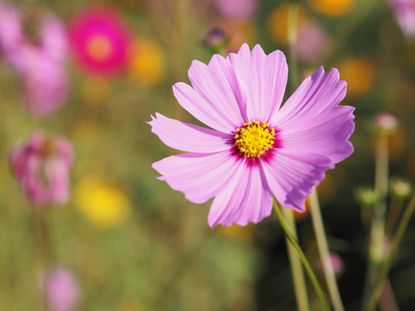Cosmos Care Made Simple: Expert Guide To Growing Cosmos
Growing pretty osmos flowers can be as simple as scattering a few seeds. A tall, brightly colored annual, cosmos can reseed and bloom year after year.


Expert Guide To Growing Cosmos For Easy Border Beauty
Growing cosmos plants at home is a quick and easy way to beautify your summer landscape. Thriving in both beds and containers, these beauties are low-maintenance with a charming, carefree growth habit.
Cosmos rewards us with bursting blooms from summer through fall. Their hardworking pink-purple tones sway atop wiry stems within weeks from planting, attracting pollinators and creating habitat for local wildlife. This guide will explore growing cosmos in greater detail, taking special interest in their cultivation and continued care throughout the season.
QUICK FACTS:
- Botanical name:
- Cosmos binpinnatus
- Height: 12-48 in.
- Spread: 24-36 in.
- Sun exposure: Full sun
- Soil requirements: Neutral, slightly alkaline
- Hardiness zones: Annual, USDA Zones 2-11
- When to plant: Spring
Caring for Cosmos
- Lighting Conditions
- Be sure that your cosmos garden beds receive full sun. These plants will bloom best where they can receive at least 6-8 hours of direct light each day. Though they can tolerate less, too much shade may result in tall or leggy stems as well as poor flower production.
- Temperature & Humidity
- A tender annual, cosmos cannot tolerate cool temperatures. When they’re planted too early they may not germinate well or can show stunted growth through the spring. Cosmos flourish where conditions remain warm, with their ideal range between 60-80F (16-27C) Humidity is only seldom a consideration at planting, as the flower is well-adapted to varying levels of atmospheric moisture.
- Watering Needs
- To grow cosmos from seed, keep your flower beds consistently moist throughout the germination process. Though established plants are able to better withstand brief periods of drought, cosmos appreciates steady rainfall. You may need to provide supplemental irrigation where conditions are especially dry or when the plants are grown in pots and containers. Use deep-watering techniques, watering at a rate of 1 inch (2.5 cm) per week.
- Fertilizing
- Cosmos can thrive in less-than-ideal soils and poor fertility. Feeding is only seldom recommended, since rich or nutrient-dense soil can lead to plants that are especially weak and fragile, and those that fail to produce blooms.
- Soil & Compost
- Cosmos perform well under a wide range of soil conditions. This includes soils that are sandy, rocky, or composed of heavy clay. Provided that the planting sites drain well, you can expect your cosmos to thrive, even without the addition of compost or other soil amendments.
- Problems, Pests & Diseases
- Cosmos are only rarely affected by disease. However, fungal issues such as gray mold and powdery mildew can develop where growing conditions are less than ideal. Several types of pests may also call the plant their home. Most notable among these are aphids, which can occur in large numbers if left untreated. Throughout the season, gardeners should routinely monitor for sudden changes in plants’ appearance that may indicate trouble. This includes yellowing of foliage, stunted growth, or wilt.
When and How to Plant Cosmos
Cosmos can be planted in spring, either indoors or sown directly into the garden. If potted into trays under grow lights, be sure to do this no sooner than 2-4 weeks before the last frost date. Promptly transplant cosmos seedlings outdoors once the weather has warmed. This will help get your plants off to a strong start.
Direct seeding in prepared beds can also be done at this time, with germination occurring in as little as 7-10 days from planting. Though you may find success by simply scattering seeds, the average cosmos planting distance generally ranges between 9-12 in. (23-30 cm) apart.
Many gardeners question if they can also begin growing cosmos plants in containers. The answer to this, of course, is a resounding, “Yes!” Dwarf varieties are especially well-suited for use in pots and other ornamental planters. Like their garden counterparts, seeds and transplants can be moved outdoors as soon as the weather has warmed sufficiently in spring.
Cosmos Deadheading & Trimming
Flowering from midsummer until the arrival of the first frost in fall, cosmos produces a continued profusion of blooms, requiring only little intervention. You can help plants look their best by removing spent flowers, otherwise known as “deadheading.” Deadheading will also prevent the production and subsequent drop of mature seed into garden beds. This is especially important if you don’t want the plant to self-seed or return the following season.
Beyond deadheading, cosmos often benefits from trimming. Cut cosmos flowers make an excellent addition to homegrown arrangements and bouquets, demonstrating an impressive vase life. You may want to prune back tired plants after their initial flush of blooms as a way to stimulate the plants’ growth and flower production into fall.
Gardening tips, videos, info and more delivered right to your inbox!
Sign up for the Gardening Know How newsletter today and receive a free download of our DIY eBook "Bring Your Garden Indoors: 13 DIY Projects For Fall And Winter".
How to Propagate Cosmos
Propagating this plant is done through their seeds. Most cultivars are available at garden centers in spring, though many flower lovers choose to save the seed of open-pollinated varieties for themselves.
As noted, seeds can be sown indoors in late winter. This allows eager gardeners a “jump start” on the growing season. Seed trays require ample light and warmth in order to yield the best results. The ideal temperature for germination lies between 70-75F (21-25 C). Seeds can also be sown directly in prepared beds, provided all chances of frost have passed.
FREQUENTLY ASKED QUESTIONS
How Long Does Cosmos Take to Grow?
Though “days to maturity” will vary from one cultivar to the next, you can expect most cosmos types to begin flowering approximately 7-9 weeks from planting.
Does Cosmos Come Back Every Year?
Cosmos are annuals. The term “annual” refers to plants that grow, flower, set seed, and die within a single season. Though this year’s plants will not return, cosmos that have been allowed to set seed are known for their prolific ability to self-sow, thus, most gardeners expect the return of plants year after year.
How Do You Make Cosmos Bushy?
Cosmos plants benefit from “pinching.” Cutting or snipping the growth tip of each stem helps to promote a compact, bushier form which may even increase flower production.

Becca Badgett was a regular contributor to Gardening Know How for ten years. Co-author of the book How to Grow an EMERGENCY Garden, Becca specializes in succulent and cactus gardening.
-
 Elegant Exotics: 8 Beautiful Amaryllis Varieties That Will Brighten Any Holiday Display
Elegant Exotics: 8 Beautiful Amaryllis Varieties That Will Brighten Any Holiday DisplayWhether red, pink, white or variegated, the right amaryllis varieties can enhance any living space, especially during the holidays. We round up eight of the most exquisite
By Bonnie L. Grant
-
 Forage For Herbs: 7 Tasty And Safe Wild Herbs To Pick Close To Your Own Backyard
Forage For Herbs: 7 Tasty And Safe Wild Herbs To Pick Close To Your Own BackyardIn addition to growing your own herbal staples, did you know there are several wild options out there that are safe and tasty – and free? Try foraging these 7 wild herbs
By Amy Grant
-
 Cutting Back Cosmos For More Blooms
Cutting Back Cosmos For More BloomsCutting cosmos will give you new flowers for the entire growing season as well as blooms for floral arrangements. Click to learn when and how.
By Mary Ellen Ellis
-
 Sulphur Cosmos Information – How To Grow A Mexican Aster Flower
Sulphur Cosmos Information – How To Grow A Mexican Aster FlowerBy Mary Ellen Ellis
-
 Cosmos Plant Varieties: Learn About Types Of Cosmos Plants
Cosmos Plant Varieties: Learn About Types Of Cosmos PlantsWhen it comes to considering the many types of cosmos plants on the market, gardeners are faced with a wealth of riches. Learn about a few of the best cosmos plant varieties and cosmos flower types for the garden in this article.
By Mary H. Dyer
-
 Cosmos Flower Diseases – Reasons Cosmos Flowers Are Dying
Cosmos Flower Diseases – Reasons Cosmos Flowers Are DyingCosmos plant diseases range from fungal to bacterial and into insect vectored viruses. Controlling insects, providing proper irrigation and planting healthy plants can minimize these problems. Click here to learn more in this article.
By Bonnie L. Grant
-
 Companion Plants For Cosmos – Learn About Cosmos Companion Plants
Companion Plants For Cosmos – Learn About Cosmos Companion PlantsWhat grows well with cosmos, and why do cosmos need companions? Companion planting serves a number of valuable purposes in the garden. Click this article to find out what plants grow well with cosmos in the garden.
By Mary H. Dyer
-
 Common Insects On Cosmos: Treating Pests On Cosmos Plants
Common Insects On Cosmos: Treating Pests On Cosmos PlantsCosmos plant pests are rare and generally don't cause significant damage to the health of the plant. What pests do cosmos get? Learn about treating pests on cosmos plants in this article and keep your flowers looking beautiful.
By Bonnie L. Grant
-
 Caring For Chocolate Cosmos Plants: Growing Chocolate Cosmos Flowers
Caring For Chocolate Cosmos Plants: Growing Chocolate Cosmos FlowersChocolate isn't just for the kitchen, it's also for the garden, especially a chocolate one. Growing chocolate cosmos flowers will delight any chocolate lover. This article had information on its care in the garden. Click here to learn more.
By Gardening Know How
-
 Cosmos Not Flowering: Why Are My Cosmos Not Blooming
Cosmos Not Flowering: Why Are My Cosmos Not BloomingCosmos is a showy annual plant commonly grown in gardens. But what happens when there are no blooms on cosmos? Read this article to learn more about why cosmos will not flower.
By Susan Patterson